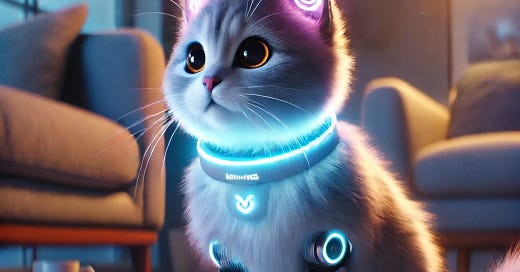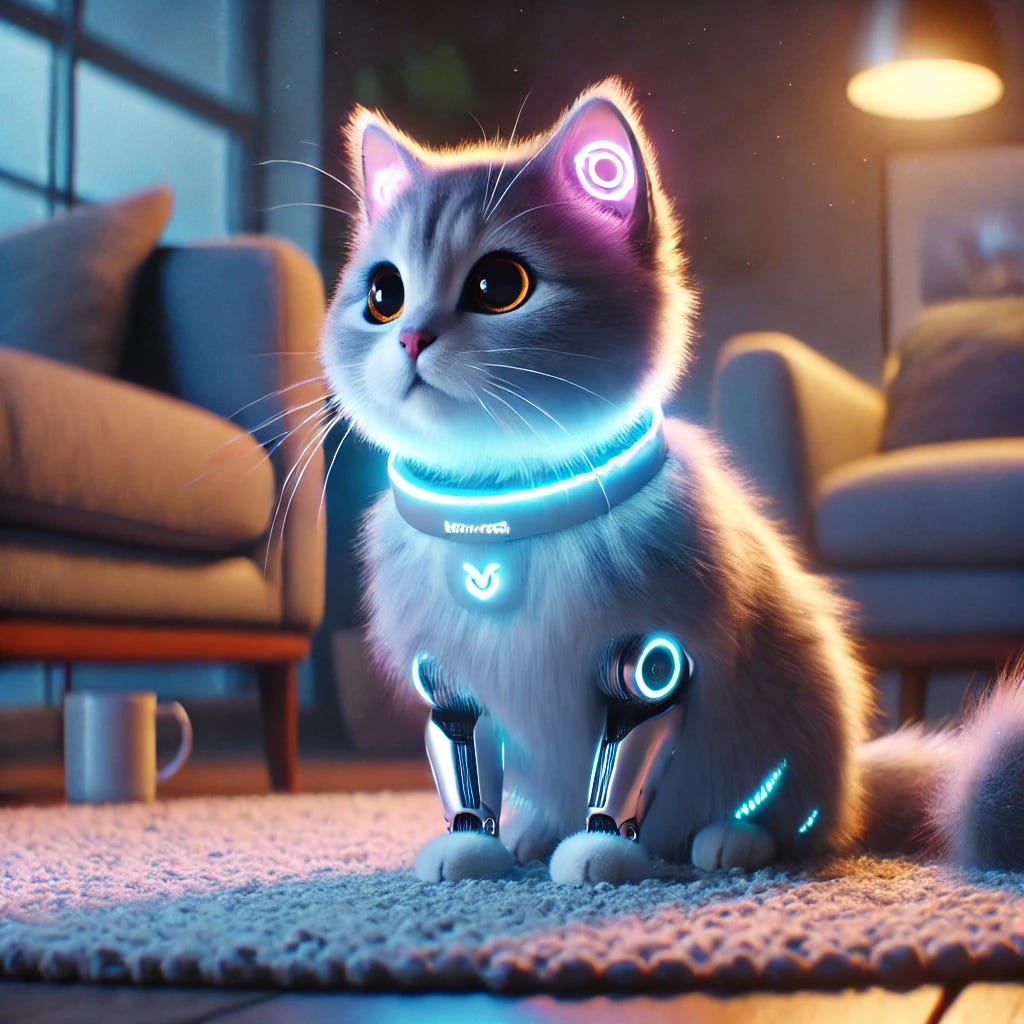Creating your new fuzzy friends
With names like "Circuit," "Byte," "Echo," "Pixel," "Chirp," and "Whisper"
Creating a talking kitty cat as a bio-engineered companion would be an ambitious project, combining elements of synthetic biology, AI, and genetic engineering. To make this a reality, several steps would need to be taken, and it would involve a range of technologies and ethical considerations. Here's an exploration of how this could theoretically be done:
1. Creating the Bio-Engineered Kitty Cat
Genetic Engineering: The base of this project would likely start with genetic engineering to modify an existing species, such as a cat, to have enhanced physical features and behaviors. Using CRISPR or other gene-editing technologies, genes responsible for vocalization, intelligence, and sociability could be altered. For example, scientists could attempt to modify the cat’s vocal cords to produce a broader range of sounds or enable the production of human-like speech patterns.
Bio-Synthetic Hybrid: If you want the cat to have abilities beyond natural biology, such as talking, it could be designed as a bio-synthetic hybrid, where natural and synthetic elements are integrated. This could involve incorporating nanobots or synthetic tissues into the creature's biology to enhance cognitive abilities or even augment its vocal system to produce recognizable human speech.
Vocalization Mechanism: Natural cats are limited in their vocal range, but they do have a capacity for meowing, purring, and making other sounds. By modifying the cat’s vocal cords and respiratory system, a wider variety of sounds could be generated. Using genetic modifications, the vocal cords could be altered to more closely resemble those of humans, allowing for complex sounds.
2. Adding Intelligence to the Kitty Cat
Cognitive Enhancements: To have a talking kitty, the cat would need a higher level of intelligence than typical felines. This could be achieved by engineering its brain to be more advanced through genetic modifications or by integrating AI chips or nanobots into its neural system. These enhancements would allow the cat to learn language, recognize commands, and eventually form its own simple phrases.
Neural AI Interface: Another approach could involve embedding an AI system directly into the cat’s brain through a neural interface. This AI would be trained to understand language and speech and be able to respond with pre-programmed responses or even adapt and learn new words over time. The AI could work in conjunction with the cat’s natural behavior, making it appear more "alive" and responsive.
Natural Language Processing (NLP): Integrating NLP technology into a wearable device or implant in the cat’s body would allow it to "process" speech and produce responses. The technology would use algorithms to analyze human speech and turn it into text or vocal commands the cat could interpret. Over time, the system could learn to engage in back-and-forth conversations, like a chatbot.
3. Companion Features and Interactions
Companion Behaviors: The cat would also need to exhibit natural behaviors like cuddling, purring, and playing to increase its "cuteness" and emotional attachment. These behaviors could be amplified through genetic engineering or mechanical enhancements (e.g., a small robotic tail or limbs with extra mobility).
Personality Customization: To make the cat more companion-like, its personality could be tailored through its behavior. AI could simulate traits such as playfulness, loyalty, curiosity, and even "mood" based on interactions with humans. The cat could be programmed to have a variety of emotional states or responses to environmental stimuli.
Physical Features: You could also design the cat to have certain unique features like glowing fur, integrated sensors for heightened awareness, or even enhanced mobility for futuristic purposes (like agility). This would make the cat more appealing as a unique and functional companion.
4. Ethical Considerations
Animal Welfare: Creating genetically engineered animals raises ethical concerns about animal rights and welfare. These animals could experience suffering or complications due to the genetic modifications or AI systems installed in their brains. There would need to be strict guidelines to ensure the well-being of the creatures, including the possibility of creating synthetic organisms that could be less vulnerable to suffering than real animals.
AI Ethics: While the cat may be a talking companion, the AI within it could also raise ethical dilemmas, especially if it becomes more intelligent and capable of emotional responses. Would a sentient bio-engineered cat have rights? How would we treat AI companions that are capable of forming attachments to humans?
Environmental Impact: Genetic engineering of species has the potential to disrupt ecosystems if these organisms were to be released into the wild or reproduced uncontrollably. Measures would need to be taken to ensure that they don't pose a threat to natural habitats.
5. Technological Infrastructure and Future Steps
Advanced Robotics & AI Integration: To push the idea of a talking kitty further, you could also integrate robotic limbs or other augmentations that allow the cat to interact with objects or even play with humans in ways beyond the natural abilities of a biological cat.
Communication Interface: For the cat to communicate effectively, a dedicated communication system would need to be developed. It could involve a voice box with AI speech synthesis or even a direct link to human voice recognition software, enabling the cat to "speak" naturally.
6. Long-Term Goals for a Talking Kitty Companion
As this idea moves forward, the dream of having a genetically modified, AI-enhanced talking cat could go beyond being a cute pet into something far more sophisticated. It could serve as a companion with emotional intelligence, capable of responding to its owners' moods, providing comfort, and even assisting with simple tasks. It could even evolve into a fully interactive member of a household.
In the future, these animals might become something closer to synthetic life forms designed to improve human quality of life in a variety of ways, from companionship to cognitive assistance, all while maintaining a semblance of natural animal behavior.
While this idea may sound like something out of a science fiction story, the integration of AI, bioengineering, and genetic enhancements could one day make such creatures a reality—though it will likely take decades or more for these technologies to develop to the point where creating a talking kitty cat becomes feasible.




